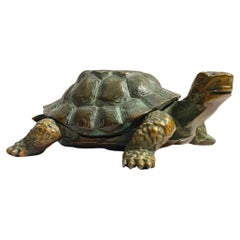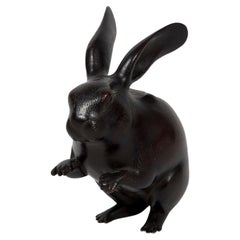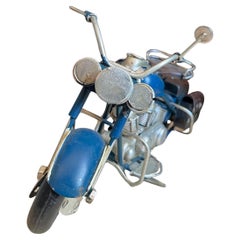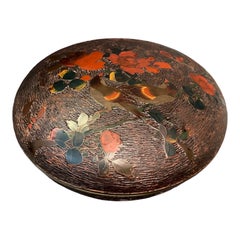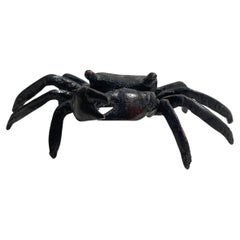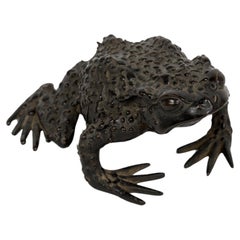Paris - Metalwork
to
3
1,054
609
40
1
1
5
25
10
1
3
3
3
2
1
41
33
4
2
2
40
37
36
2
1
41
40
41
Item Ships From: Paris
Japanese Little Bronze Turtle Jewerly Box 1980s
Located in Paris, FR
This is an objet of turtle which you can use as a jewelry holder.
This is made with bronze and it was made in Japan around 1980s.
The thing that written on the bottom of the turtle i...
Category
1980s Japanese Showa Vintage Paris - Metalwork
Materials
Bronze
Bronze okimono sculpture of a standing hare
Located in PARIS, FR
Bronze sculpture with a gorgeous brown patina, that represents a standing hare, with one of its paws up. Its head is treated with great realism and the care in which parts like fur a...
Category
Late 19th Century Japanese Meiji Antique Paris - Metalwork
Materials
Bronze
Japanese Tin Plate Toy Blue MotorCycle 1960s
Located in Paris, FR
This is a Japanese Toy which was made around 1960s in Japan.
This motorcycle object was made with some tin plates (Buriki in Japanese).
These kind of toy got inspired by American vin...
Category
1960s Japanese Showa Vintage Paris - Metalwork
Materials
Tin
Large Japanese Cloisonné Box and Cover, Japan, Meiji Period, 19th Century
Located in PARIS, FR
A rare Japanese bark tree large cloisonné box on metal from the Meiji period. Usually bark tree cloisonné was on porcelain (totai Shippo)
A very attracti...
Category
Late 19th Century Japanese Antique Paris - Metalwork
Materials
Metal
$2,476 Sale Price
25% Off
Japanese Antique Bronze Crabe 1930-40s Showa era
Located in Paris, FR
Object of crab with bronze:
A very precious object made before the second world war, when bronze was rare to find.
-Details-
Era: Showa (around 1930-1939)
Materials: Bronze
Category
Mid-20th Century Japanese Showa Paris - Metalwork
Materials
Bronze
Japanese bronze okimono toad (sculpture)
Located in PARIS, FR
Okimono bronze sculpture of a large toad in a crouching position, possibly about to jump.
The toad and the frog, referred to by the same term in Japanese (kaeru), are associated with...
Category
Mid-19th Century Japanese Japonisme Antique Paris - Metalwork
Materials
Bronze
Bronze okimono sculpture of an hare lying down
Located in PARIS, FR
Bronze sculpture with a brown patina that represents a hare lying down with an arched back. Its head and several other details are treated with great realism, from the texture of its...
Category
Late 19th Century Japanese Meiji Antique Paris - Metalwork
Materials
Bronze
Bronze okimono sculpture of a catfish or namazu
Located in PARIS, FR
Sculpture or okimono in bronze of a wavy catfish emerging from calm water, scales are not represented, and its expression of eyes and mouth could be considered naive. One other inter...
Category
Early 20th Century Japanese Taisho Paris - Metalwork
Materials
Bronze
Brass Perfume Burner, Persia 19th century
Located in PARIS, FR
Brass incense burner with openwork decoration of interlacing, scrolls and foliage.
Four registers on the body depict zoomorphic and anthropomorphic patterns.
The base has been re-ass...
Category
19th Century Antique Paris - Metalwork
Materials
Brass
Jizai okimono bronze sculpture of an articulated praying mantis
Located in PARIS, FR
Bronze Jisai Okimono sculpture of a praying mantis, partially articulated, deep brown patina. Both front legs and head are fixed in a rather realistic posture while the four other le...
Category
Late 19th Century Japanese Meiji Antique Paris - Metalwork
Materials
Bronze
Japanese Bronze sculpture representing a puppy lying down
Located in PARIS, FR
Bronze okimono sculpture with a deep brown patina, representing a lying puppy, probably of shiba inu breed. This kind of subject is common in traditional Nippon sculptures, this spec...
Category
Late 19th Century Japanese Meiji Antique Paris - Metalwork
Materials
Bronze
Japanese Tiny bronze frog
Located in PARIS, FR
Adorable tiny bronze frog in cast bronze with a splendid brownish patina, almost
orange, lying on its rear legs, ready to jump. The casting of this bronze was very well
conducted, ...
Category
Late 19th Century Japanese Meiji Antique Paris - Metalwork
Materials
Bronze
Bronze sculpture of a rat standing on a radish (Okimono)
Located in PARIS, FR
This beautiful bronze okimono depicts a mouse delicately perched on a leafy radish. The mouse, resting on its two hind legs, has a long tail that wraps around the radish. Each elemen...
Category
Late 19th Century Japanese Meiji Antique Paris - Metalwork
Materials
Bronze
Bronze sculpture of an eagle on a tree stump, to be used as an incense burner
Located in PARIS, FR
This bronze sculpture represents a royal eagle standing on top of a tree stump. Its body and the stump were realized separately and mounted, the transition being right above the talo...
Category
Early 19th Century Japanese Edo Antique Paris - Metalwork
Materials
Bronze
Japanese bronze sculpture of a frog hidding in a lotus leaf (Okimono)
Located in PARIS, FR
A small bronze sculpture of a frog emerging from a huge lotus leaf, a small but detailed beetle on the other side of the leaf. The frog (kaeru) is associated with luck and wealth. In...
Category
Early 20th Century Japanese Taisho Paris - Metalwork
Materials
Bronze
Japanese okimono sculpture of a lying puppy with its head facing its rear
Located in PARIS, FR
Bronze okimono sculpture with a deep brown patina, of a lying puppy, probably of shiba inu breed, represented with its head facing its rear. This kind of subject is common in traditi...
Category
Late 19th Century Japanese Meiji Antique Paris - Metalwork
Materials
Bronze
Bronze okimono sculpture of a huge cicada lying on a bamboo segment
Located in PARIS, FR
Huge bronze sculpture in the form of a cicada standing on a bamboo segement. This type of sculpture of small dimensions with a flat base is generally used by calligraphs to maintain ...
Category
Late 20th Century Japanese Meiji Paris - Metalwork
Materials
Bronze
Bronze sculpture of two cicadas on a bamboo, used by calligraphs to hold paper
Located in PARIS, FR
Two cicadas in bronze facing each other on a bamboo segment
One is an adult while the other is at the nymph phase. Three foundry stamps, one underneath and one alongside each insect...
Category
Late 19th Century Japanese Meiji Antique Paris - Metalwork
Materials
Bronze
Japanese bronze sculpture of a ginseng root, ganodermas mushrooms growing on it
Located in PARIS, FR
Bronze sculpture representing a group of genoderma mushrooms developing on the long stem of a Ginseng root that is standing on two kakis. Logically this root would be Panax ginseng, ...
Category
Late 19th Century Japanese Meiji Antique Paris - Metalwork
Materials
Bronze
Japan mice treasure bag Meiji
Located in PARIS, FR
Japanese bronzewith brown patina representing two mice. One is pulling pulling a treasure bag. crouching down with its head turned to the left. While the other mouse is standing on i...
Category
Late 20th Century Japanese Japonisme Paris - Metalwork
Materials
Bronze
Japanese lantern in cast iron decorated with colourfull enameled champleve.
Located in PARIS, FR
Tall hexagonal lantern in bronze with a blue, red and green enamel openwork with stylized lotus flower motives. The shaft has a nice brown patina. The base is decorated with taotie m...
Category
Early 20th Century Chinese Paris - Metalwork
Materials
Bronze, Enamel
Japanese Bronze sculpture of a standing Mouse holding an Hazelnut
Located in PARIS, FR
It is a very convincing bronze sculpture of a mouse with a light brown patina, represented with an astonishing set of detail on its eyes, nose and fur. She is seated on her rear paws...
Category
Late 19th Century Japanese Meiji Antique Paris - Metalwork
Materials
Bronze
Japanese Bronze sculpture of a Mouse holding a korn knob
Located in PARIS, FR
An interesting bronze sculpture of a seated mouse holding a small corn knob. Realistic treatment of the fur, eyes, hears nose and mouth, its tail is curving on the left side of the s...
Category
Late 19th Century Japanese Meiji Antique Paris - Metalwork
Materials
Bronze
Opium Wieght in the Form of a Buddhist lion
Located in PARIS, FR
Tiny opium weight in bonze with brownish patina in the shape of a Buddhist guardian lion, also name Fo dog, characteristic with its exorbitated eyes and an embossed and wavy mane and...
Category
Late 19th Century Cambodian Folk Art Antique Paris - Metalwork
Materials
Bronze
Large Indo-Persian Tray in Embossed Brass, India 19th Century
Located in PARIS, FR
Superb large Indo-Persian tray in embossed brass with magnificently intricate arabesque decorations of foliage, animals and divinities. Representation of ...
Category
Mid-19th Century Indian Antique Paris - Metalwork
Materials
Brass
Japanese Bronze Group of Mice, Pumpkin and Pomegranate
Located in PARIS, FR
Polychrome bronze of a group of mice around a pumpkin and a pomegranate. The five mice have a dark brown patina, while the hollowed-out gourd is dark brown and the split pomegranate ...
Category
Late 19th Century Japanese Antique Paris - Metalwork
Materials
Bronze
Reliquary Urn in Brass
Located in Paris, FR
Urn reliquary in polished brass. In two parts, base
and lid.
Category
21st Century and Contemporary Indonesian Paris - Metalwork
Materials
Brass
$456 Sale Price / item
20% Off
Articulated iron sculpture or Jizai (articulated) in the form of a butterfly
Located in PARIS, FR
Fine iron jizai of an articulated butterfly with fascinating openwork on its wings. In 1876, the Haitōrei decree was proclaimed, prohibiting the use of swords by anyone other than th...
Category
Late 19th Century Japanese Meiji Antique Paris - Metalwork
Materials
Bronze
Japanese Bronze Hawk Ikebana
Located in PARIS, FR
Bronze intended for hanging (? dô kakenanaike, « hanging bronze ») depicting a hawk, placed on a branch. The inside is hollow so a bouquet a flowers can be put inside and thus, serve...
Category
Late 19th Century Japanese Antique Paris - Metalwork
Materials
Bronze
Japanese bronze incense burner in the form of an owl Signed Murata Seimin 村田製眠
Located in PARIS, FR
A bronze okimono of an owl, constructed in two sections, the short-eared owl (detachable) perched on a tree branch with its head cocked quizzically to the right and its wings folded ...
Category
18th Century Japanese Edo Antique Paris - Metalwork
Materials
Bronze
Pair of japanese bronze vase imitating hay and decorated with a grass hopper
Located in PARIS, FR
Detailed pair of vases in bronze of baluster form, textured to represent straws of hay, bound together by three knots that divide each vase in three, just under le second ring, a well detailed grasshopper is detached from the rest of the composition.
Insects (mushi) occupy an important place in Japanese culture. Hunting for insects is a popular pastime, especially among children. Using plastic nets and cages, they catch cicadas and beetles to observe them.
Between 1830 and 1832, Hokusai composed an untitled series of ten large horizontal prints...
Category
Late 19th Century Japanese Meiji Antique Paris - Metalwork
Materials
Bronze
Pair of Japanese Abumi Stirrups
Located in PARIS, FR
Pair of stamped brass stirrups decorated with Hashizuka, Ito and Manabe Mons.
Japan - Edo (1615-1868), 18th century.
Height: 10.24 in. (26 cm), length: 12.6 in. (32 cm), width 4.72 in. (12 cm)
As in Western culture, the culture Japanese stirrups were part of traditional accessories...
Category
Late 18th Century Japanese Antique Paris - Metalwork
Materials
Brass
$6,991 / set
Japanese Cast Bronze Mirror and lacqer box, Edo Period, 18th Century, Japan
Located in PARIS, FR
A heavy and finely cast Japanese bronze mirror decorated with pines , cranes wich are longevity symbols, The handle in the center is a a tutle which also symbolize longevity.
Edo Period, 18th century, Japan.
The small, round mirror with high walls has been intricately and exquisitely cast with symbols . The turtle has a domed shell pieced to allow a cord to be strung through for handling or hanging.
A five charactesr mark is cast on the border.
Mirror is 12 ,3 x 1,6 cm
Box is 14,2 x 5 cm
Surrounding the turtle and inscription is a densely cast landscape featuring pine trees with fantastic needles, two cranes with their 3 youngs, dense stalks of leafy bamboo. and a blooming prunus on the left side.
All are symbols of longevity. Bamboo also symbolizes resilience and prosperity. Bamboo asociated with prunus and pine are called the 3 frinds of winter.
The other side of the mirror is undecorated, and would originally have been highly polished, allowing the user to see their reflection in the polished surface.
The bronze with a wonderful, warm silver patina.
This mirror is presented in its original lacquer box , hand decorated in the Kodaiji style with gold lacquer flowers...
Category
Late 18th Century Japanese Japonisme Antique Paris - Metalwork
Materials
Bronze
$1,165 Sale Price
20% Off
Pair of Japanese Bronze Grasshopper Vases
Located in PARIS, FR
Insects (mushi) occupy an important place in Japanese culture. Hunting for insects is a popular pastime, especially among children. Using plastic nets and cages, they catch cicadas and beetles to observe them.
Between 1830 and 1832, Hokusai composed an untitled series of ten large horizontal prints...
Category
Late 19th Century Japanese Antique Paris - Metalwork
Materials
Bronze
$5,825 / set
Japanese Bronze Vase decorated with a Phoenix and paulownia leaves
Located in PARIS, FR
Patinated bronze vase decorated with a flying phenix and paulownia leaves. The phoenix has imperial and solar symbolism. This bird of good omen also embodies virtues from the teaching of Confucius (such as goodness, righteousness, and wisdom). Paulownia (kiri) is considered as a symbol of nobility, honor and longevity. Since the Edo era, there has been a tradition that paulownia is planted at the birth of a daughter to be used later as a material for making items that will be part of her dowry. Its wood is ideal for chests and kimono boxes...
Category
20th Century Japanese Showa Paris - Metalwork
Materials
Bronze
Japanese Bronze Kappa
Located in PARIS, FR
Dark brown patina bronze figure of a standing kappa with its right leg leaning on a cucumber. The figure is put on four-legged rattan-like bronze stand.
The kappa (??) is a aquatic creature taken from Japanese folklore having the appearance of an anthropomorphic turtle.
His skull is either slightly hollowed out to accommodate water, from which it derives its power, or hidden with a water lily leaf hiding this sag. Naturally polite, it is advisable to bow to him in order that it should do so in return, thus losing all the water he has gathered and leaving it harmless.
Kappa has the reputation of attempting to lure both humans and animals into the water. In some areas, it ravages fields, stealing eggplants and cucumbers. Some people prefer to worship it and give it offerings rather than be its victims.
Signed Shokaken (???). His real name is Ôshima Yasutarô. He was born in 1849 and is the third generation of a metalworkers family. Together with his brother Ôshima Joun...
Category
Late 19th Century Japanese Antique Paris - Metalwork
Materials
Bronze
$5,243
Japanese Bronze leaf and snail tray signed Ishikawa Toshio (1919-2006, 石川敏夫)
Located in PARIS, FR
Small bronze tray with green patina in the shape of a leaf with a snail on it.
Signature underneath « Toshi » (敏) Ishikawa Toshio.
Sold with its transport box
Japan, Ishikawa Toshio...
Category
1960s Japanese Showa Vintage Paris - Metalwork
Materials
Bronze
Ikebana in bronze of an Hawk designed to display flowers hanged on the wall
Located in PARIS, FR
Bronze intentded for hanging (銅掛斜生, dô kakenanaike, « hanging bronze ») depicting a hawk, placed on a branch. The inside is hollow so a bouquet a flowers can be put inside and thus, ...
Category
Late 19th Century Japanese Meiji Antique Paris - Metalwork
Materials
Bronze
Japan medallions tsuba Tanaka school Edo period
Located in PARIS, FR
Ovoid-shaped (nagamarugata) iron tsuba hammered and chased with medallions. On one side, medallions of a dragon with gold highlights and a komainu (or shishi – lion dog guarding the ...
Category
Mid-18th Century Japanese Antique Paris - Metalwork
Materials
Gold, Iron
Owl on a Tree Stump
Located in PARIS, FR
Bronze sculpture representing an owl on a tree stump covered with ivy. The owl, detachable from its base, has shakudo eyes. It is certainly an Ryûkyû scops ...
Category
Late 19th Century Japanese Antique Paris - Metalwork
Materials
Bronze
$16,312
Japan chrysanthemum tsuba
Located in PARIS, FR
Iron tsuba in the shape of a chrysanthemum (kikugata), openworked in negative with foliage and geometric patterns. Chrysanthemum shaped tsuba were quite popular in the Edo period as...
Category
Mid-18th Century Japanese Antique Paris - Metalwork
Materials
Gold, Iron
Recently Viewed
View AllMore Ways To Browse
Arabic Dallah
Bronze Elephant Incense
Chinese Censer Dragon
Cloisonne Dog
Dallah Arabic Coffee Pots
Antique Persian Copper Tray
Brass Arabic Coffee Pot
Bronze Asian Charger
Bronze Temple Bowl
Chinese Bronze Ding
Foo Dog Incense Burners
Japanese Bronze Vase With Silver Inlay
Japanese Koro Silver
Large Japanese Bronze Incense Burner
Antique Cast Iron Kettle
Chinese Cloisonne Charger
Chinese Deer Bronze
Copper Dallah
